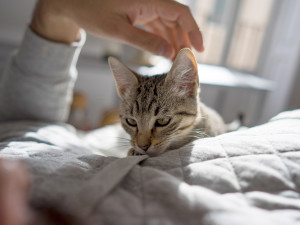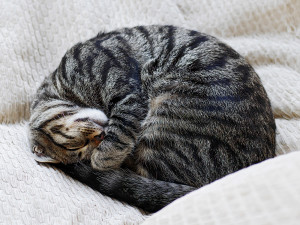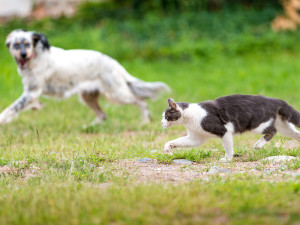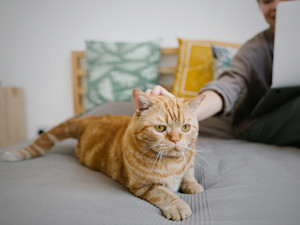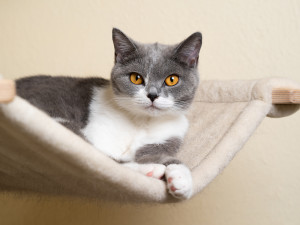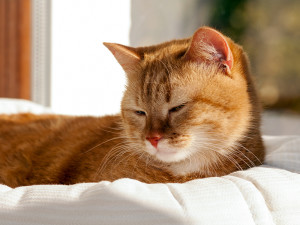Why is My Cat Twitching in Their Sleep?
Why do they do it? Here are the top three reasons your cat twitches in their sleep — from sweet dreams to scary spasms.
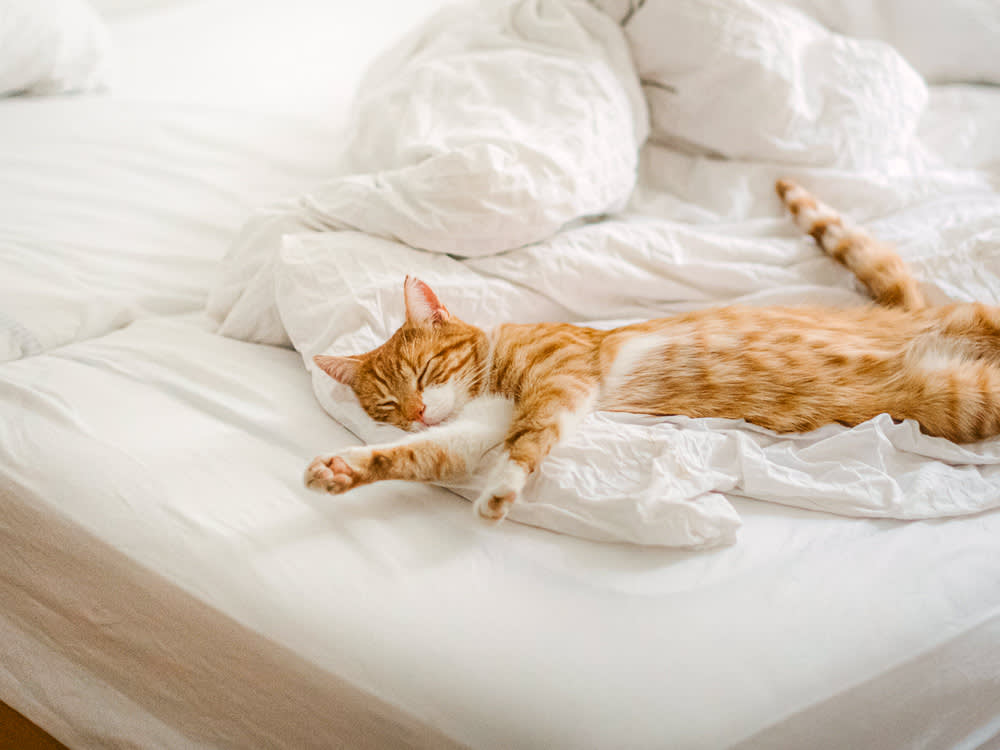
share article
Does your cat move so much in their sleep it looks like they’re trying to run a freakin’ marathon? Cats twitch in their sleep for a variety of reasons, including dreaming, muscle spasms, and medical conditions. If you notice your cat twitching in their sleep, it’s important to observe them closely to see if there are any signs of distress. If your cat is also panting, drooling, having trouble breathing, or seems agitated, it is best to consult with your veterinarian to rule out any medical causes.
Many cat parents wonder if their cat shaking when sleeping is normal. For almost all cats, twitching, jerking, ear flicking, and tail swishing can all be a part of normal sleep. So, don’t be scared to post those cute kitten twitches to your story, as long as you know to watch out for the signs that could indicate a sleep disorder or other problem.
Cat sleep habits
Every cat parent knows that cats are great sleepers, though their cats don’t always choose to doze at the most convenient times. Naturally crepuscular, cats tend to be most active in the evening and early morning hours. This is why many cats think that 4 a.m. is the optimal time for feeding and roughhousing. This also means that opens in a new tab is spent lounging or sleeping.
Normal cats sleep 12 to 13 hours per day,opens in a new tab though this amount can vary based on age and activity level. A cat’s sleep cycle lasts about 75 minutes, which is shorter than the normal human sleep cycle of 90 to 120 minutes.
A cat’s sleep periods alternate between two to 10 minutes of rapid eye movement (REM) sleep and 12 to 15 minutes of non-REM sleep. During non-REM sleep, cats are completely still and have some muscle tone (stiffness) present. During REM sleepopens in a new tab, the muscles are completely relaxed, but there can be brief bursts of activity, including movement of the limbs, eyes, whiskers, ears, and tail.
What causes twitching during sleep?
There are many possible causes of twitching during sleep. Some common ones include:
1. Dreams
Just like people, cats go through rapid eye movement (REM) and non-REM cycles when they sleep. During REM sleep, the body is relaxed, but the brain is actively processing the day’s events. We assume that cats dream during REM sleep because they show similar brain activity patterns to humans while sleeping, but they can’t tell us, so no one knows for sure.
Some mild muscle twitching can be normal during REM sleep and may be associated with dream activity. The good news is that little twitches of the face, legs, ears, and tail are not a reason for concern and should be considered a cute part of a cat’s normal sleep. The not-as-good news is that there may be other non-dream-related reasons for your cat to twitch while sleeping. We checked in with Dr. Elizabeth Shines to learn more.
2. Allergies
“Twitching during sleep, followed by waking and immediately grooming, could indicate itchy skin related to fleas, allergies, matted fur, or a skin infection,” Dr. Shines says. “Make sure to check your cat routinely for fleas and keep their coat in good condition.” If you see your cat twitching their ears excessively, that could indicate ear mites or an ear infection. “You may notice that the twitching is followed by scratching or rubbing at the ears,” Dr. Shines adds. “Ear mites and infections will often cause a build-up of waxy debris in the ears, so check your pet’s ears regularly.”
3. Seizures
On a slightly scarier note, cats who experience seizures can exhibit signs, such as twitching, shaking, spasms, and tremors. Seizures are often associated with a change in brain activity, and that includes falling asleep or waking up. In addition to twitching, during a seizure, a cat’s limbs might go rigid, and they may lose control of their bowels or bladder. If you suspect your cat is having seizures, contact your vet right away so they can begin investigating any underlying health issues.
Because the signs of a seizure can have some overlap with twitching seen during sleep, it’s good to know a couple of ways to differentiate the two. If a cat is having some kitty dreams and twitching, they should wake up quickly and act normally if touched or gently shaken. Cats having a seizure will not stop their movement when you try to wake them. They will appear disoriented (faraway expression, drooling, unsteady, unusual behavior) for 15 minutes to an hour after the event. Contact a veterinarian if you think your cat has had a seizure.
4. Muscle spasms
Cat muscle spasms while sleeping can look a lot like normal twitching. True muscle spasms are more violent than the gentle kicks and flicks associated with normal sleep. Muscle spasms can occur due to toxins like opens in a new tab found in flea products made for dogs, neurological issues, pain, or a sleep disorder. Because these are hard to differentiate from normal sleep activity, take a video to show your vet if you are concerned about them.
5. Parasomnias
Parasomnias are types of sleep disordersopens in a new tab that involve abnormal movements, behaviors, or vocalizations while asleep. These are not common or well-understood in cats. They can occur secondary to genetic disorders, brain tumors, or metabolic diseases. Injury to a specific part of the brain called the pontine tegmentumopens in a new tab can even cause a cat to sleep walk, but this is extremely rare. Some of the movements seen with sleep disorders can look like seizures. But unlike the jerking seen during a seizure, these movements will stop as soon as the cat is woken up.
If your cat is active for extended periods while they seem to be sleeping, experiencing more intense activity than some small twitches, growling or hissing while sleeping, take videos and contact your veterinarian. Most sleep disorders are diagnosed based on recorded or described symptoms and an appropriate response to waking during events (ruling out a seizure) because diagnostic sleep studies are not commonly performed in cats. Work-up with a veterinary neurologist would be needed to find brain lesions creating sleep disorders or causing seizure during sleep.
6. Developing nervous system
It’s been theorized that a rapidly developing nervous system could make a kitten twitch more than an adult cat while sleeping. Kittens are even more difficult to do sleep studies on than older cats, so information on this is pretty limited.
Is twitching related to age?
Mild twitching during sleep can be normal in cats of any age. Anecdotally, people have noted that kittens tend to be more active when they’re sleeping. As long as they act normally when woken up and the movements are not disrupting their ability to get quality sleep, it’s generally considered benign.
FAQs (People also ask):
Should I wake my cat while twitching?
Mild twitching can be normal during deep sleep and doesn’t need to be stopped. If the twitch is intense or frequent, you can wake them up to make sure they snap out of it. Don’t disrupt their deep sleep constantly, or they’ll get pretty grumpy.
How can I ensure my cat’s sleep is comfortable?
The best way to make sure your cat sleeps well is to provide a cozy area where they can feel safe and protected. Cats don’t love sleeping near loud noises, in exposed areas, or around unfamiliar animals or people.
Is it normal for cats to twitch?
It can be normal for cats to have some mild twitching of their whiskers, ears, tail, or limbs while they’re sleeping. These movements should be minor and relatively brief.
References

Kate Sheofsky
Kate Sheofsky hails from San Francisco, where she developed a love of writing, Giants baseball, and houses she can’t afford. She currently lives in Portland, OR, and works as a freelance writer and content strategist. When not typing away on her laptop, she enjoys tooling around the city with her two rescue pups searching for tasty food and sunny patios.

Dr. Bartley Harrison, DVM
Dr. Bartley Harrison, DVM is a small animal veterinarian based in North Carolina who has practiced emergency medicine since graduating from the Texas A&M College of Veterinary Medicine. His primary interest areas include pain management, cardiology, and the treatment of shock.
He is a member of the Veterinary Emergency and Critical Care Society, American Veterinary Medical Association, and American Medical Writers Association. In addition to his clinical work, he writes pet health articles to help provide accurate information for both new and experienced pet parents. When he’s not working, he enjoys cooking, traveling, reading, and going on adventures with his dog.
Related articles
![Blue white British shorthair cat resting on a hammock]() opens in a new tab
opens in a new tab7 Cat Hammocks That Make the Perfect Lounge Accessory for Your Kitty
Hang loose, little dudes.
![Red cat with squinted eyes laying in a basket closeup]() opens in a new tab
opens in a new tab6 Ways Your Cat Could Tell You They Are in Pain
Here are all the way your kitty is trying to tell you they’re hurting.
![MoMA’s pets pop up at the MoMA Design Store]() opens in a new tab
opens in a new tabMoMA Has the Pop-Up Store of Your Artsy Pet Parent Dreams
A watermelon-shaped litter box, crocheted toys, and harnesses and leashes that come in colors your favorite TikTok influencer would envy.
![A senior cat is held in their owner's lap]() opens in a new tab
opens in a new tabHow to Care for Your Senior Cat
From taking them to the vet more often to giving them a hand with grooming, older kitties need a little extra TLC.
![Man sitting with cats, surrounded by flowers]() opens in a new tab
opens in a new tabLounge
Here are the beds, dog crates, cat towers, and everything else your pet needs to curl up and catch a snooze. Or stare at you from their cozy perch while you fulfill their every need.
